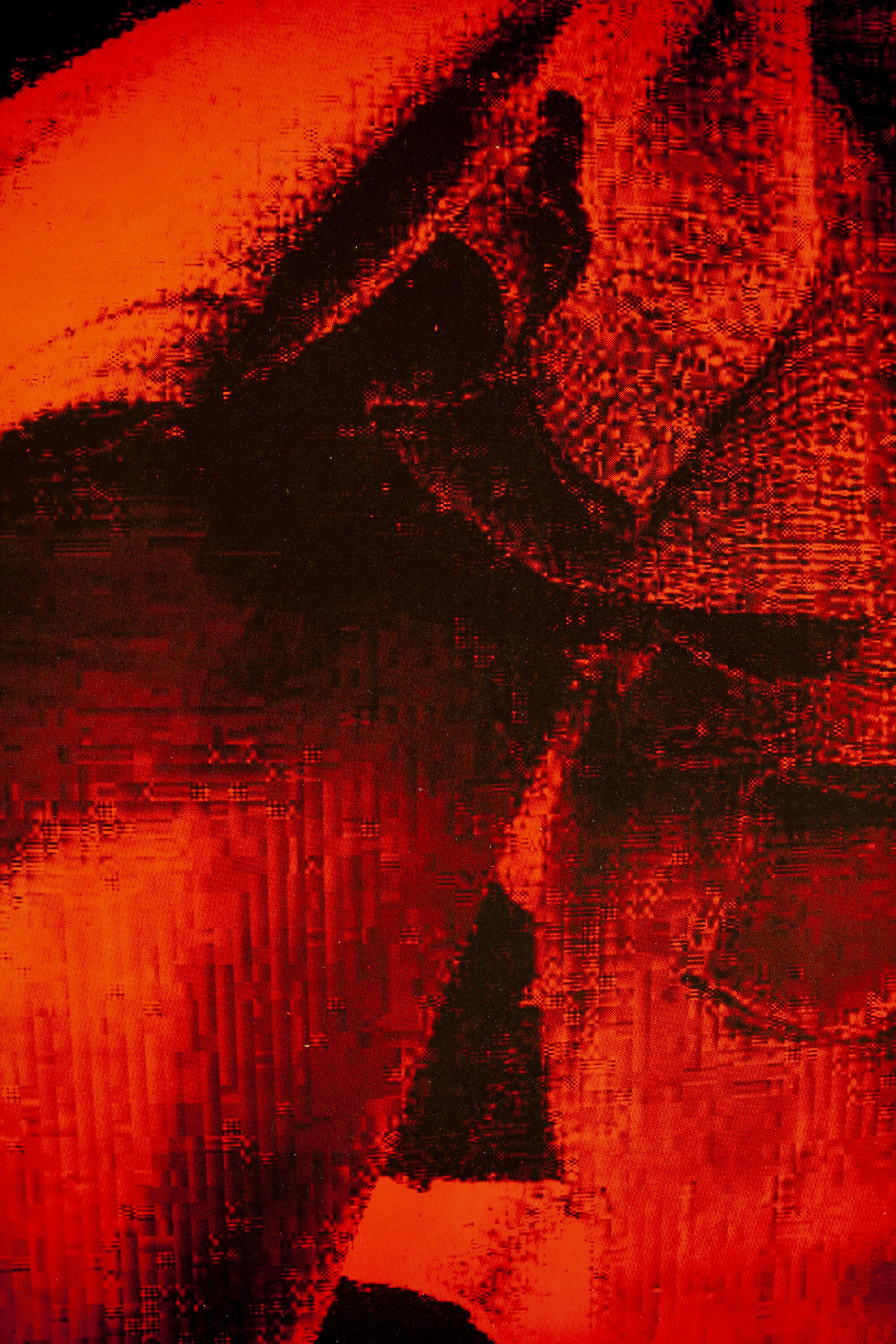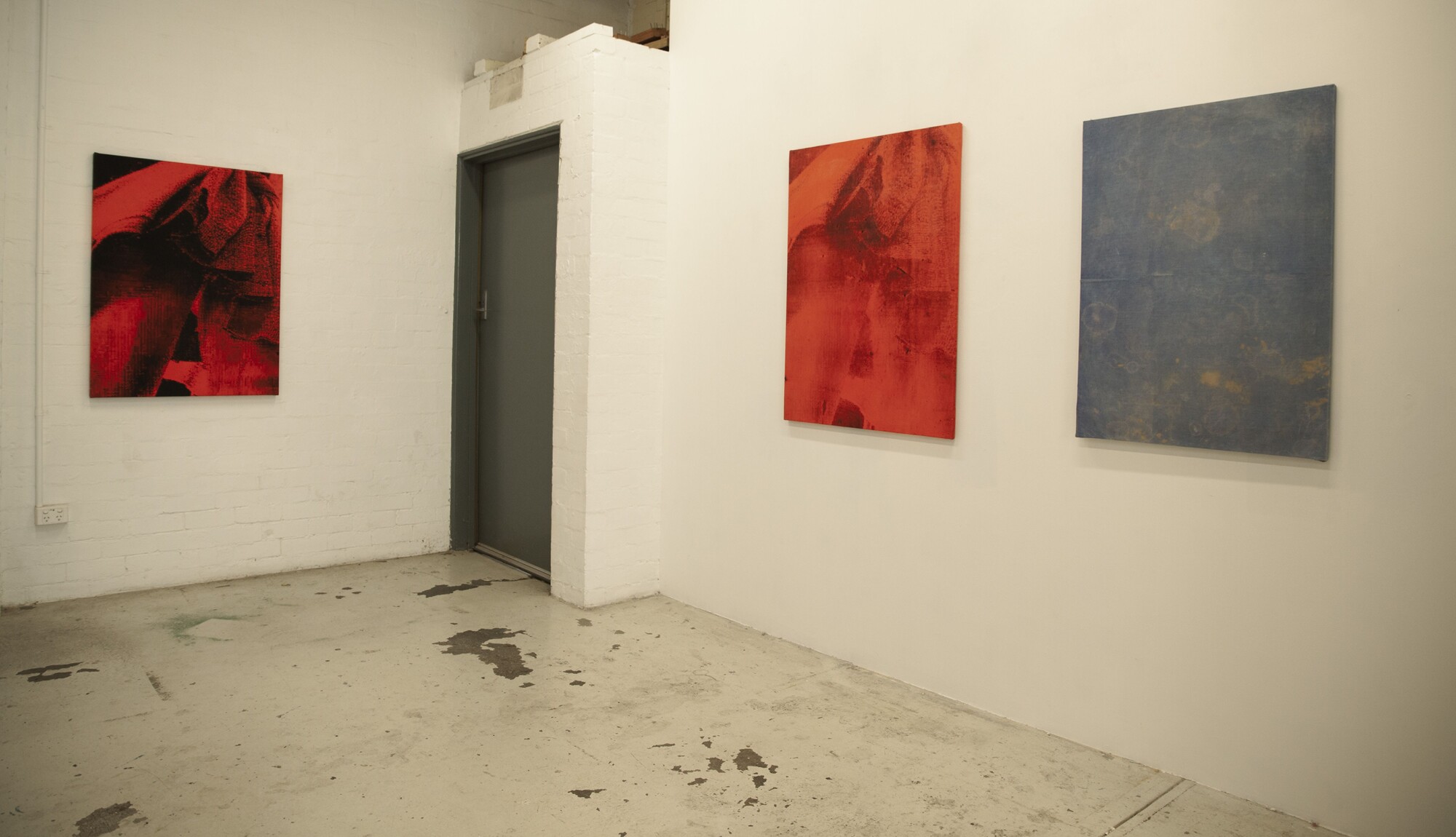Nicole Thomson, Love Exposure
Helen O'Toole
To be transparent, I own an artwork by Nicole Thomson, whose new exhibition Love Exposure at TCB is the subject of this review. The work I live with is a pencil drawing of a love heart whose shape is repeated in expanding concentric rings from the centre of the page out past its margins. The love heart also radiates light/energy: a striated, shiny cone emanates from its core, cloaking the paper in a second layer of lead. What rescues this work from the twee trajectory we might otherwise ascribe to a love heart is the latent violence of the object. The pencil layers are so worked up, so dense, so utterly obsessional and claustrophobic, that the process of drawing here begins to unpick its own paper support. The artist’s concentrated application of pencil has, in several areas, put holes in the paper—worn it down to nothing. This violent interplay between a medium and its support is a useful entry point to Love Exposure, which marries themes of love, care and desire with a dark, cannibalistic edge.
The new exhibition at TCB comprises five wall-mounted works: three sky-blue cyanotype-like prints on linen, and two black silk screen prints on lurid red canvas. The photograms are made of old bed sheets painted with purple solar-fast pigment, exposed to sunlight, then washed to fix the image in place—turning the pigment blue in the process. The silhouette imprinted on each of these works indexes a chain-link fence topped with barbed wire. (Specifically, the fence opposite the artist’s studio.) This image is most clearly registered in the large Fence, which is made from an old doona cover for a double bed; it’s perceptible in the more purple-hued Diamond of god and a neighbour with satan, made from a pillow case; but is barely legible in Florida Water, the matching pillowcase that hangs on the opposite wall.
The hard diamond grid pattern of the fence figures forth the fine soft weave of the linen support into which it is imprinted, in much the same way that Agnes Martin’s graphite grids have been be said to figure forth their canvas support in a self-reflexive way. But the used manchester in Fence is noticeably threadbare in several places, where holes reveal the gallery wall or wooden stretcher behind. Unlike children’s cyanotypes, so often made up of playful arrangements of found leaves, flowers and feathers, the barbed-wire imprint of Fence reads as if it might be responsible for the holes in the linen itself, as if the very act of capturing the image has begun to bring about its own destruction. Indeed, the large 1:1 scale and banal urban referents of this work recall the “black shadows” imprinted on the earth by the atom bombs dropped on Hiroshima and Nagasaki at the close of World War II.

Strangely enough—as Thomson is not exactly an ecowarrior—the blue works strongly invite an ecocritical reading. She had to collaborate with the weather to get a twenty-minute exposure with maximum sunlight and minimal wind. The chemical exposure also brought forward an unexpected array of bodily fluids (traces of which were embedded in the sheets) that interacted with the pigment and sunlight so that they appear to bloom like algae on the surface of water. (See Florida Water in particular.) This reading of a distributed agency across human and non-human actors in the co-production of the work is in some ways forced, but it also helps us begin to conceive of the expanded support structure subtending it, one that moves beyond a reductive, positivist Greenbergian paradigm of paint/canvas or pencil/paper. The linen itself, Thomson tells me, was stolen for her by an ex-partner at her request, thereby drawing social relations into the structure of the work’s technical support.

A social structural support can also be said to underpin the two prints in the exhibition. Both have been pulled from the same screen, though where one is high contrast the other is washed out. Their actual content is hard to discern as the digital image on which it’s based has been “deep fried” (pixelated to near oblivion). But we learn from the room sheet that the image is derived from upskirt photography—an antisocial and criminal form of pornography. It is significant that the screen used to pull the prints belonged to a much-loved mutual friend, no longer with us, Liam Osborne. Even the colour scheme and pictorial treatment of Skirt I (Love Exposure) and Skirt II (Welcome to the N.H.K.) reads like an homage to his degraded prints and noise music. Osborne was a continuous structural support for the local art scene, building galleries and studios, and helping friends with installs. As George Egerton-Warburton recently put it, quite beautifully, “his legacy is literally part of the infrastructure of this community, its walls and floors and terms of engagement”. A case in point: Osborne big-heartedly built a free-standing wall for Thomson and Corrie Wilson’s 2019 exhibition at Bus Projects, So Much Fun, on which Thomson hung her collages.

In recent pandemic years, the artworld has been at risk of drowning in a discursive sea of “care”, “mutual aid” and “support”. In this context, support often conjures up the warm and fuzzies through its connotations of intimacy, proximity, assistance and protection—in spite of the lack thereof from government, council and workplace, etc. But, as artist Celine Condorelli has sharply observed, support structures also point to a lack and a violence, “the violence of support”. She writes: “providing support and being supportive implies not only being in contact, but being right up against the subject of concern (…) To work in support also means working towards the hypothetical disappearance of a lack, of the need for support, which are the basis for this intimacy in the first place: once more, against it.” After completing honours at Monash in 2019, Thomson began to winnow away at this lack that is the need for support in a technical sense. She enrolled in a carpentry course at TAFE to alleviate the dependency on others for her builds, along with advancing her life-long dream to build a house.

In this light, consider Thomson’s most recent exhibition prior to Love Exposure, which was a solo show at Meow for which she built a version of the Unabomber’s cabin from scratch inside the North Melbourne share house, using timber, repurposed cardboard and plasterboard, as well as stickers and pressed clovers as sparse ornamentation. Against the grain of mutual aid, this work (made amidst 2021 Melbourne lockdowns) groped toward an act of radical self-sufficiency—one that referenced the anti-industrial manifesto of Theodore Kaczynski, as well as Henry David Thoreau’s treatise for self-reliance detailed in his book Walden; or, Life in the Woods, which documents his effective withdrawal from society to live a life of introspection in a simple cabin by Walden Pond. Not unlike Absalon’s ascetic Cells—white-washed, minimalist dwellings built for single-occupancy living, but which also, like anchorite cells, closely echo the form and function of tombs—Thomson’s cabin was an artwork that, paradoxically, rehearsed its own disappearance from the artworld.

Sentiments of alienation, depression, loneliness and social withdrawal haunt Love Exposure too, particularly the two silk screen prints. The scopophilic Skirt I and II reference psychosexual alienation, both in their content and titular references. The subtitle Welcome to the N.H.K. refers to the eponymous Japanese novel and later anime series about the widespread phenomenon of hikikomori (recluses who lock themselves away in their bedrooms for years on end). Love Exposure is the name of a 2008 cult film about a son alienated from his father who is a Catholic priest. The son’s only recourse to his father’s love and attention is through the vehicle of confession—a realisation that leads the protagonist to commit a range of sins in order to confess them, predominantly by taking illegal upskirt photos.

Thomson is presumably drawn to these themes—of alienation, depression, isolation and withdrawal—for the same reasons as the institutions and individuals who’ve been propagating the “care pandemic” across art, curation and theory in recent years. That is, these affective conditions are all symptoms of the broken, late-stage capitalist, neoliberal, necropolitical regime we currently find ourselves in. They are what Byung-Chul Han would describe as the “signature afflictions” of our age. But by the same token, Thomson clearly resiles from the uncritical, self-congratulatory tone of many such projects, preferring instead to recalibrate the diagnosis rather than offer up its cure. In her work, she refuses an easy recuperation of a deficit into a positive, and repudiates the pressure to strive in spite of structural indifference, if not outright hostility. In Love Exposure, as well as in other recent exhibitions by Thomson, we see this more complex relationship to care iterated across her treatment of support structures, whether medium-specific, ecological or social. Here, the artwork’s support is figured as a site of conflict, violence and struggle even as it represents the artwork’s very condition of possibility.
Helen O’Toole is a writer from Melbourne.


